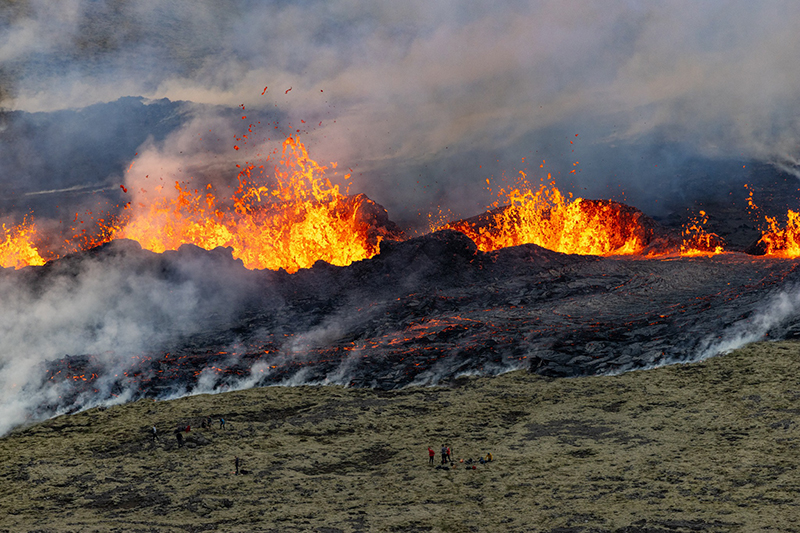 After millennia of fiery eruptions, Smoking Mountain, the iconic volcano that has shaped both the landscape and culture of the surrounding region, appears to be entering a period of dormancy. Geologists monitoring the once-active peak have reported a steady decline in volcanic activity over the last decade, with recent measurements suggesting the eruptions that once defined the mountain’s identity may be coming to a close. For locals, the fading fire signals not only the end of a geological era but also marks the gradual disappearance of a force that has been central to their history, mythology, and way of life.
After millennia of fiery eruptions, Smoking Mountain, the iconic volcano that has shaped both the landscape and culture of the surrounding region, appears to be entering a period of dormancy. Geologists monitoring the once-active peak have reported a steady decline in volcanic activity over the last decade, with recent measurements suggesting the eruptions that once defined the mountain’s identity may be coming to a close. For locals, the fading fire signals not only the end of a geological era but also marks the gradual disappearance of a force that has been central to their history, mythology, and way of life.
### **A Geological Giant Winds Down**
Smoking Mountain, long known for its unpredictable bursts of activity, has been a dominant presence in the region’s landscape for thousands of years. Historically, the volcano erupted every few decades, shaping ecosystems with lava flows and fertile ash deposits. However, over the past ten years, its eruptions have grown less frequent, smaller in scale, and less intense. Recent seismic readings indicate that the magma chamber beneath the mountain is steadily cooling, suggesting that the volcano could be entering a prolonged period of dormancy—or perhaps even extinction.
Volcanologist Dr. Hannah Devereaux, who has studied Smoking Mountain for much of her career, explains the phenomenon: “Volcanoes are like living organisms—they have life cycles, periods of activity and rest. What we’re witnessing is likely the natural end of a phase that began thousands of years ago. While it’s impossible to say for certain, this could mean that Smoking Mountain will go quiet for centuries, or even permanently.”
### **Cultural Significance and Emotional Impact**
For the communities living in the shadow of the volcano, Smoking Mountain has always been more than a geological feature. Generations of locals have woven stories, traditions, and spiritual beliefs around the mountain’s eruptions, seeing its fire as a symbol of life, renewal, and destruction. For indigenous groups, the volcano was considered a sacred entity, with each eruption believed to be a sign from the gods—a message of rebirth or warning.
“The mountain has always been a part of who we are,” says tribal elder Lito Sanchez. “We celebrated its fire, but we also feared it. It gave us fertile land to grow our food, but it also reminded us that we were small in the face of nature’s power. If the mountain really does go silent, it will feel like losing a part of our soul.”
Local festivals that celebrated the eruptions, including the “Festival of Fire” held every few years, may now have to adapt to this new reality. Organizers are considering turning the event into a memorial of sorts, honoring the history of the mountain rather than its ongoing eruptions. “It’s strange to imagine celebrating the absence of the fire,” says festival organizer Rosa Medina, “but we need to find a way to carry the mountain’s spirit forward, even if it sleeps.”
### **Ecological Shifts and Economic Concerns**
The cooling of Smoking Mountain will also bring changes to the island’s ecosystem. The volcanic ash and occasional lava flows once helped to rejuvenate the soil, providing nutrients that allowed rare plants to flourish. Without the volcano’s influence, ecologists worry that some of the island’s unique flora and fauna may struggle to survive. “Volcanic ecosystems are dynamic by nature,” says environmental scientist Dr. Julian Webb. “When the eruptions stop, you lose that source of renewal, and the landscape can begin to degrade or change in unexpected ways.”
In addition to the environmental shifts, the fading eruptions raise economic concerns for communities that rely on tourism. Smoking Mountain has long been a major attraction, drawing adventurers, geologists, and photographers from around the world. With the volcano entering dormancy, tourism revenue may decline, leaving local businesses searching for new ways to attract visitors.
“We built a whole industry around the volcano,” explains hotel owner Marco Reyes. “Tours, hiking excursions, cultural events—everything revolved around the mountain’s fire. Now that it’s fading, we’ll need to rethink how we market the area. It’s going to be tough.”
### **The Legacy of a Sleeping Giant**
While the fading fire of Smoking Mountain signals the end of one chapter, it also opens the door to a new era of reflection and adaptation. Scientists are now shifting their focus from studying eruptions to understanding how ecosystems respond to volcanic dormancy, while locals are beginning to explore new ways of relating to the mountain that has shaped their identity for generations.
Despite the challenges, there is a sense of quiet reverence for what the mountain has given over the years. “We have lived through its eruptions, and we’ve survived the ash, the lava, and the fear,” says Sanchez. “Now we’ll see what life looks like without the fire.”
Geologists caution that the volcano’s dormancy might not be permanent—volcanic systems can lie silent for centuries before reawakening. But for now, Smoking Mountain’s silence marks the end of an era, a rare moment of calm after millennia of turmoil.
As the last plumes of smoke dissipate into the sky, the mountain stands as a reminder of nature’s unpredictability—always changing, always evolving. Whether the fire returns someday or remains extinguished forever, the legacy of Smoking Mountain will endure, etched in the hearts and memories of those who lived beneath its shadow.
And so, the mountain that once burned bright may sleep at last, leaving behind only whispers of fire and echoes of ash.
